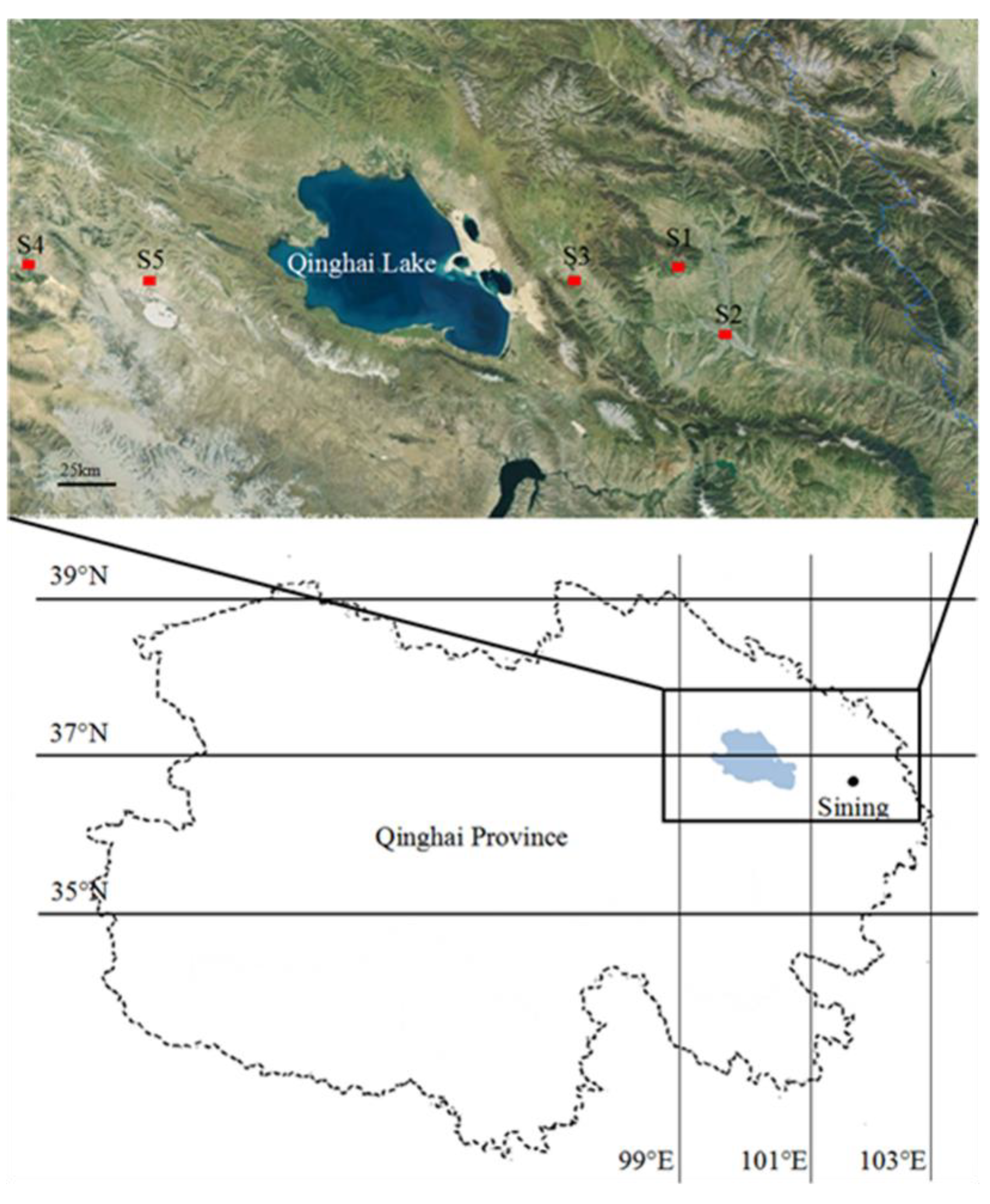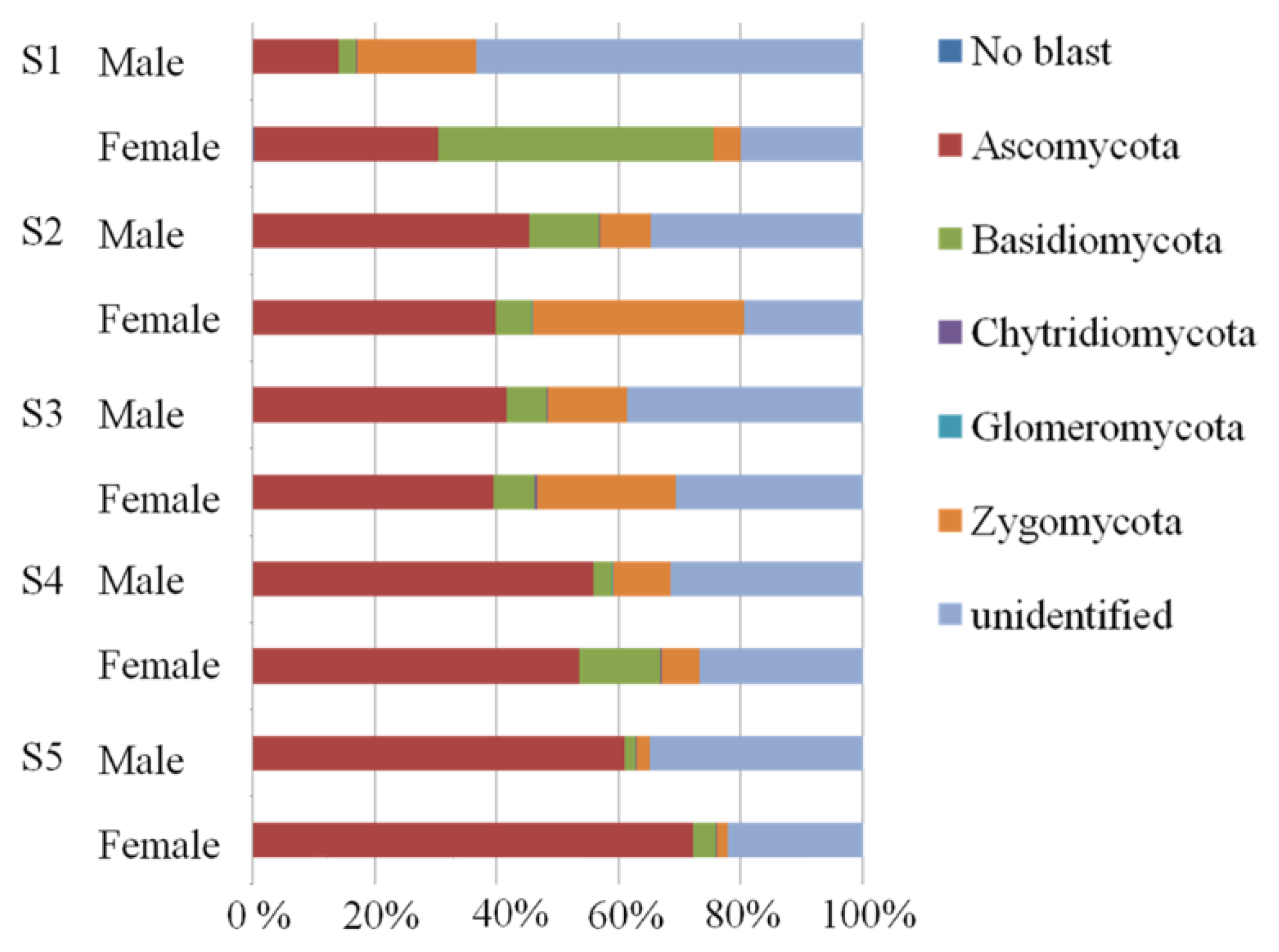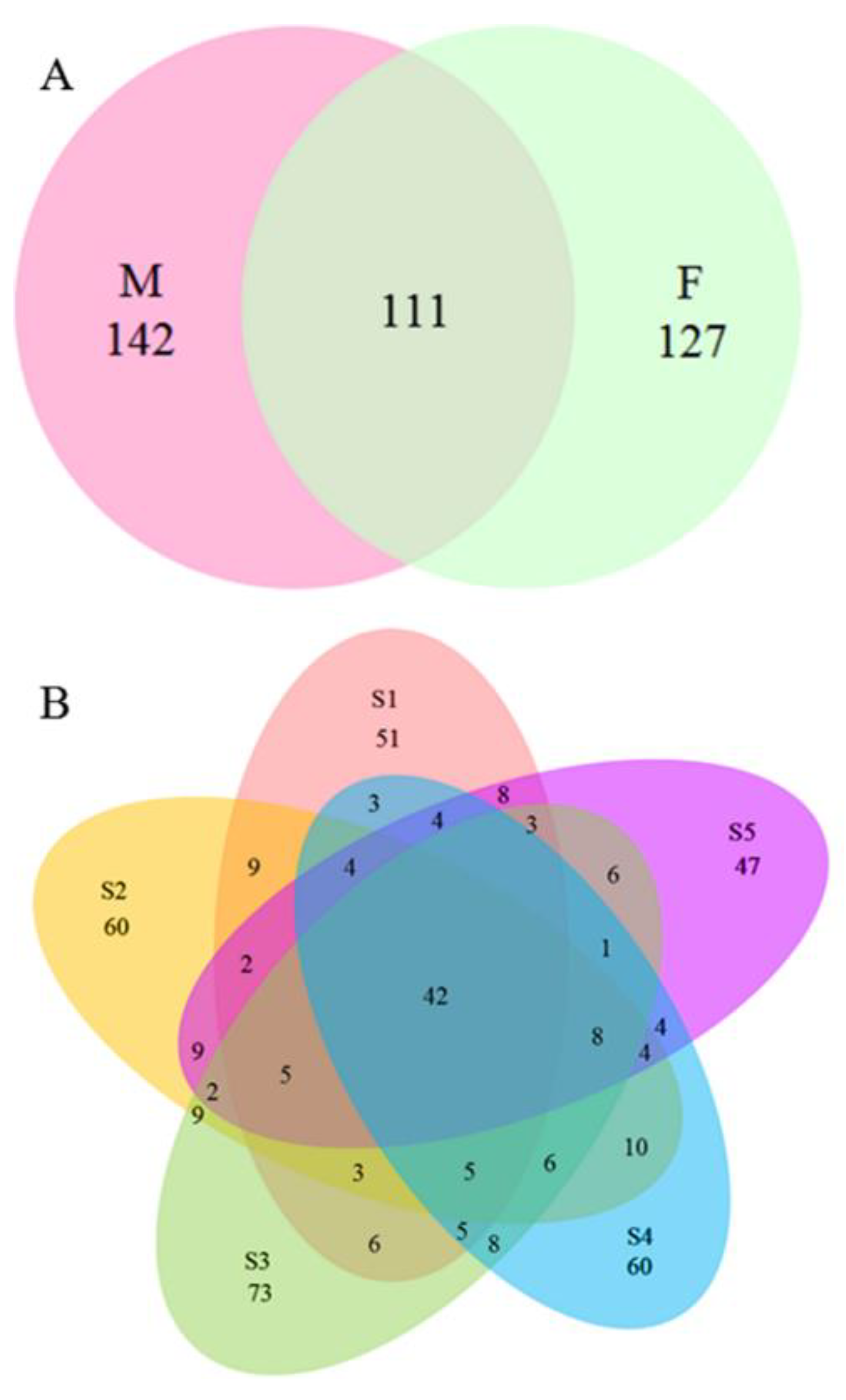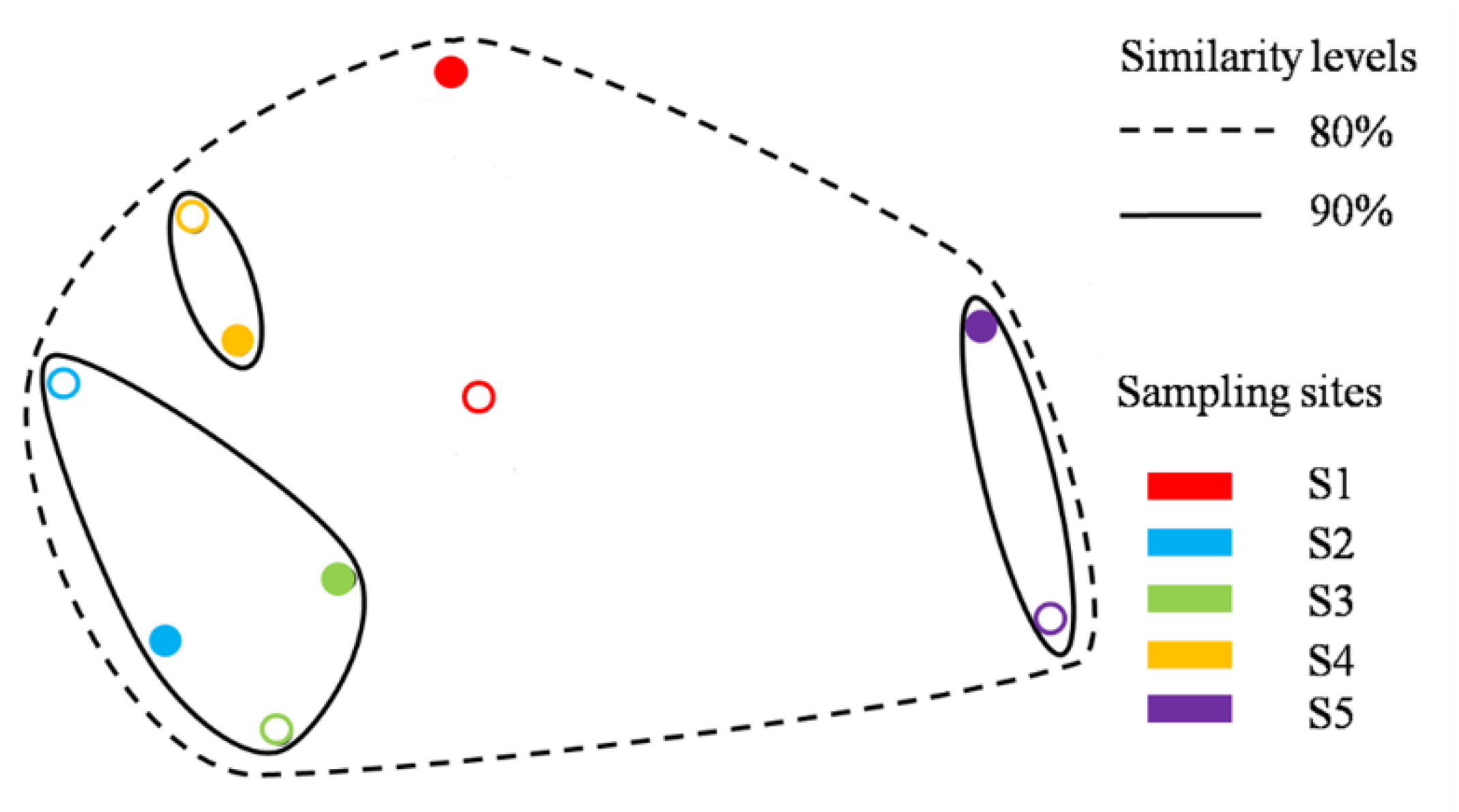Gender Effects of Dioecious Plant Populus cathayana on Fungal Community and Mycorrhizal Distribution at Different Arid Zones in Qinghai, China
Abstract
:1. Introduction
2. Materials and Methods
2.1. Site Description and Soil Sampling
2.2. Soil Properties Measurement
2.3. Mycorrhizal Infection and GRSP Assessment
2.4. DNA Extraction and Sequencing
2.5. Statistical Analysis
3. Results
3.1. Distribution of Soil Elements
3.2. Soil Chemical Properties
3.3. Mycorrhizal Status and Glomalin Contents
3.4. Fungal Taxon Identification and Alpha Diversity
3.5. RDA Results
4. Discussion
5. Conclusions
Author Contributions
Funding
Data Availability Statement
Acknowledgments
Conflicts of Interest
References
- Wang, J.; Fu, B.; Lu, N.; Zhang, L. Seasonal variation in water uptake patterns of three plant species based on stable isotopes in the semi-arid Loess Plateau. Sci. Total Environ. 2017, 609, 27–37. [Google Scholar] [CrossRef]
- Seleiman, M.F.; Al-Suhaibani, N.; Ali, N.; Akmal, M.; Alotaibi, M.; Refay, Y.Y.; Dindaroglu, T.; Abdul-Wajid, H.H.; Battaglia, M.L. Drought stress impacts on plants and different approaches to alleviate its adverse effects. Plants 2021, 10, 259. [Google Scholar] [CrossRef]
- Dai, A. Increasing drought under global warming in observations and models. Nat. Clim. Change 2013, 3, 52–58. [Google Scholar] [CrossRef]
- Funk, C.; Harrison, L.; Alexander, L.; Peterson, P.; Behrangi, A.; Husak, G. Exploring trends in wet-season precipitation and drought indices in wet, humid and dry regions. Environ. Res. Lett. 2019, 14, 115002. [Google Scholar] [CrossRef]
- Li, Z.; Wang, X.L.; Liu, Y.S.; Zhou, Y.Y.; Wu, N.; Bian, Z. Water uptake and hormone modulation responses to nitrogen supply in Populus simonii under PEG-induced drought stress. Forests 2022, 13, 907. [Google Scholar] [CrossRef]
- Li, Z.; Wu, N.; Liu, T.; Chen, H.; Tang, M. Effect of arbuscular mycorrhizal inoculation on water status and photosynthesis of Populus cathayana males and females under water stress. Physiol. Plantarum 2015, 155, 192–204. [Google Scholar] [CrossRef]
- Wu, N.; Li, Z.; Wu, F.; Tang, M. Microenvironment and microbial community in the rhizosphere of dioecious Populus cathayana at Chaka Salt Lake. J. Soil. Sediment. 2019, 19, 2740–2751. [Google Scholar] [CrossRef]
- Wu, N.; Li, Z.; Meng, S.; Wu, F. Soil properties and microbial community in the rhizosphere of Populus alba var. pyramidalis along a chronosequence. Microbiol. Res. 2021, 250, 126812. [Google Scholar] [CrossRef]
- Han, Y.Y.; Lou, X.; Zhang, W.R.; Xu, T.Y.; Tang, M. Arbuscular mycorrhizal fungi enhanced drought resistance of Populus cathayana by regulating the 14-3-3 family protein genes. Microbiol. Spectr. 2022, 10. [Google Scholar] [CrossRef]
- Qu, Z.L.; Santalahti, M.; Köster, K.; Berninger, F.; Pumpanen, J.; Heinonsalo, J.; Sun, H. Soil fungal community structure in boreal pine forests: From southern to subarctic areas of Finland. Front. Microbiol. 2021, 12, 653896. [Google Scholar] [CrossRef]
- Coleine, C.; Stajich, J.E.; Selbmann, L. Fungi are key players in extreme ecosystems. Trends Ecol. Evol. 2022, 37, 517–528. [Google Scholar] [CrossRef]
- Fu, W.; Chen, B.D.; Jansa, J.; Wu, H.H.; Ma, W.; Luo, W.T.; Xu, C.; Hao, Z.P.; Wu, H.; Yu, Q.; et al. Contrasting community responses of root and soil dwelling fungi to extreme drought in a temperate grassland. Soil Biol. Biochem. 2022, 169, 108670. [Google Scholar] [CrossRef]
- Potts, L.D.; Douglas, A.; Calderon, L.; Anderson, J.A.; Witte, U.; Prosser, J.I.; Gubry-Rangin, C. Chronic environmental perturbation influences microbial community assembly patterns. Environ. Sci. Technol. 2022, 4, 56. [Google Scholar] [CrossRef]
- Cao, Y.; Chai, Y.F.; Jiao, S.; Li, X.Y.; Wang, X.B.; Zhang, Y.N.; Yue, M. Bacterial and fungal community assembly in relation to soil nutrients and plant growth across different ecoregions of shrubland in Shaanxi, northwestern China. Appl. Soil Ecol. 2022, 173, 104385. [Google Scholar] [CrossRef]
- Wu, N.; Li, Z.; Wu, F.; Zhen, L.N. Sex-specific photosynthetic capacity and Na+ homeostasis in Populus euphratica exposed to NaCl stress and AMF inoculation. Front. Plant Sci. 2022, 13, 1066954. [Google Scholar] [CrossRef]
- Han, Y.; Wang, Y.; Jiang, H.; Wang, M.; Korpelainen, H.; Li, C.Y. Reciprocal grafting separates the roles of the root and shoot in sex-related drought responses in Populus cathayana males and females. Plant Cell Environ. 2013, 36, 356–364. [Google Scholar] [CrossRef]
- Petry, W.K.; Soule, J.D.; Iler, A.M.; Chicas-Mosier, A.; Inouye, D.W.; Miller, T.E.; Mooney, K.A. Sex-specific responses to climate change in plants alter population sex ratio and performance. Science 2016, 353, 69–71. [Google Scholar] [CrossRef]
- Li, Z.; Wu, N.; Liu, T.; Chen, H.; Tang, M. Gender-related responses of dioecious plant Populus cathayana to AMF, drought and planting pattern. Sci. Rep. 2020, 10, 11530. [Google Scholar] [CrossRef]
- Phillips, M.; Hayman, D.S. Improved procedures for clearing roots and staining parasitic and vesicular–arbuscular mycorrhizal fungi for rapid assessment of infection. Trans. British Mycol. Soc. 1970, 55, 158–161. [Google Scholar] [CrossRef]
- Xu, Z.Y.; Tang, M.; Chen, H.; Ban, Y.H.; Zhang, H.H. Microbial community structure in the rhizosphere of Sophora viciifolia grown at a lead and zinc mine of northwest China. Sci. Total Environ. 2012, 435, 453–464. [Google Scholar] [CrossRef]
- Liang, X.Q.; Xu, L.; Li, H.; He, M.M.; Qian, Y.C.; Liu, J.; Nie, Z.Y.; Yu, S.; Chen, Y.X. Influence of N fertilization rates, rainfall, and temperature on nitrate leaching from a rainfed winter wheat field in Taihu watershed. Physical. Chem. Earth. 2011, 36, 395–400. [Google Scholar] [CrossRef]
- Voets, L.; de la Providencia, I.E.; Fernandez, K.; IJdo, M.; Cranenbrouck, S.; Declerck, S. Extraradical mycelium network of arbuscular mycorrhizal fungi allows fast colonization of seedlings under in vitro conditions. Mycorrhiza 2009, 19, 347–356. [Google Scholar] [CrossRef] [PubMed]
- Declerck, S.; Strullu, D.G.; Plenchette, C. In vitro mass-production of the arbuscular mycorrhizal fungus, Glomus versiforme, associated with Ri T-DNA transformed carrot roots. Mycol. Res. 1996, 100, 1237–1242. [Google Scholar] [CrossRef]
- Wright, S.F.; Upadhyaya, A. A survey of soils for aggregate stability and glomalin, a glycoprotein produced by hyphae of arbuscular mycorrhizal fungi. Plant Soil 1998, 198, 97–107. [Google Scholar] [CrossRef]
- White, T.; Bruns, T.; Lee, S.; Taylor, J. Amplification and Direct Sequencing of Fungal Ribosomal RNA Genes for Phylogenetics. In PCR Protocols: A Guide to Methods and Applications; Innis, M., Gelfand, D., Shinsky, J., White, T., Eds.; Academic Press, Inc.: San Diego, CA, USA, 1990; pp. 315–322. [Google Scholar]
- Karmakar, R.; Das, I.; Dutta, D.; Rakshit, A. Potential effects of climate change on soil properties: A Review. Sci. Inter. 2016, 4, 51–73. [Google Scholar] [CrossRef] [Green Version]
- Stefanowicz, A.M.; Majewska, M.L.; Stanek, M.; Nobis, M.; Zubek, S. Differential influence of four invasive plant species on soil physicochemical properties in a pot experiment. J. Soil. Sediment. 2018, 18, 140901423. [Google Scholar] [CrossRef] [Green Version]
- Marone, D.; Mastrangelo, A.M.; Borrelli, G.M.; Mores, A.; Laido, G.; Russo, M.A.; Maria Ficco, D.B. Specialized metabolites: Physiological and biochemical role in stress resistance, strategies to improve their accumulation, and new applications in crop breeding and management. Plant Physiol. Biochem. 2022, 172, 48–55. [Google Scholar] [CrossRef]
- Netherway, T.; Bengtsson, J.; Krab, E.E.J.; Bahram, M. Biotic interactions with mycorrhizal systems as extended nutrient acquisition strategies shaping forest soil communities and functions. Basic Appl. Ecol. 2021, 50, 25–42. [Google Scholar] [CrossRef]
- Coban, O.; De Deyn, G.B.; Vander Ploeg, M. Soil microbiota as game-changers in restoration of degraded lands. Science 2022, 375, abe0725. [Google Scholar] [CrossRef]
- Smith, S.E.; Read, D.J. Mycorrhizal Symbiosis; Academic Press, Inc.: San Diego, CA, USA, 2008. [Google Scholar]
- Armada, E.; Azcón, R.; López-Castillo, O.M.; Calvo-Polanco, M.; Ruiz-Lozano, J.M. Autochthonous arbuscular mycorrhizal fungi and Bacillus thuringiensis from a degraded Mediterranean area can be used to improve physiological traits and performance of a plant of agronomic interest under drought conditions. Plant Physiol. Biochem. 2015, 90, 64–74. [Google Scholar] [CrossRef]
- Ruiz-Lozano, J.M.; Aroca, R.; Zamarreño, Á.M.; Molina, S.; Andreo-Jiménez, B.; Porcel, R.; García-Mina, J.M.; Ruyter-Spira, C.; López-Ráez, J.A. Arbuscular mycorrhizal symbiosis induces strigolactone biosynthesis under drought and improves drought tolerance in lettuce and tomato. Plant Cell Environ. 2016, 39, 441–452. [Google Scholar] [CrossRef] [PubMed] [Green Version]
- Ban, Y.H.; Tang, M.; Chen, H.; Xu, Z.; Zhang, H.; Yang, Y. The response of dark septate endophytes (DSE) to heavy metals in pure culture. PLoS ONE 2012, 7, e47968. [Google Scholar] [CrossRef] [PubMed]
- Schmid, M.W.; Hahl, T.; Van Moorsel, S.J.; Wagg, C.; Schmid, B. Rhizosphere bacterial community composition depends on plant diversity legacy in soil and plant species identity. BioRxiv 2018. [Google Scholar] [CrossRef] [Green Version]
- Schmid, M.W.; Hahl, T.; Moorsel, S.J.V.; Wagg, C.; Deyn, G.B.D.; Schmid, B. Feedbacks of plant identity and diversity on the diversity and community composition of rhizosphere microbiomes from a long-term biodiversity experiment. Mol. Ecol. 2019, 28, 863–878. [Google Scholar] [CrossRef] [Green Version]
- Sheng, M.; Chen, X.D.; Zhang, Z.L.; Hamel, C.; Cui, X.W.; Chen, J.; Chen, H.; Tang, M. Changes in arbuscular mycorrhizal fungal attributes along a chronosequence of black locust (Robinia pseudoacacia) plantations can be attributed to the plantation-induced variation in soil properties. Sci. Total Environ. 2017, 599–600, 273–283. [Google Scholar] [CrossRef]
- Bastida, F.; López-Mondéjar, R.; Baldrian, P.; Andrés-Abellán, M.; Jehmlich, N.; Torres, I.F.; Garcia, C.; López-Serrano, F.R. When drought meets forest management: Effects on the soil microbial community of a Holm oak forest ecosystem. Sci. Total Environ. 2019, 662, 276–286. [Google Scholar] [CrossRef]
- Preece, C.; Farré-Armengol, G.; Peuelas, J. Drought is a stronger driver of soil respiration and microbial communities than nitrogen or phosphorus addition in two Mediterranean tree species. Sci. Total Environ. 2020, 735, 139554. [Google Scholar] [CrossRef]
- De Santiago, J.H.; Lucas-Borja, M.E.; Wic-Baena, C.; Andrés-Abellán, M.; Heras, J. Effects of thinning and induced drought on microbiological soil properties and plant species diversity at dry and semiarid locations. Land Degrad. Dev. 2015, 27, 1151–1162. [Google Scholar] [CrossRef]
- Yao, Z.Y.; Xing, J.J.; Gu, H.P.; Wang, H.Z.; Wu, J.J.; Xu, J.M.; Brookes, P.C. Development of microbial community structure in vegetable-growing soils from open-field to plastic-greenhouse cultivation based on the PLFA analysis. J. Soil. Sediment. 2016, 16, 2041–2049. [Google Scholar] [CrossRef]





| Sampling Sites | Longitude/Latitude | Altitude/m | Annual Precipitation/mm | |
|---|---|---|---|---|
| S1 | Chengguan (CG) | 101°30′51″ E/37°2′49″ N | 2644 | 520 |
| S2 | Sining (SN) | 101°40′50″ E/36°39′19″ N | 2271 | 390 |
| S3 | Haiyan (HY) | 101°0′18″ E/36°53′46″ N | 3004 | 380 |
| S4 | Ulan (UL) | 98°27′59″ E/36°57′10″ N | 3013 | 159 |
| S5 | Chaka (CK) | 99°4′24″ E/36°47′31″ N | 3108 | 193 |
| S5 | Chaka (CK) | 99°4′24″ E/36°47′31″ N | 3108 | 193 |
| Sample Sites | Sex | Available P (g·kg−1) | Available K (g·kg−1) | NO3-N (g·kg−1) | NH4-N (g·kg−1) | EC dmS·m−1 | pH | Water Content (%) | SOC (g·kg−1) | ALP (10−2 mg·g−1·h−1) | Catalase (mg·g−1·h−1) | Sucrase (mg·g−1·h−1) | Dehydrogenase (µg·g−1·h−1) | Urease (10−2 mg·g−1·h−1) |
|---|---|---|---|---|---|---|---|---|---|---|---|---|---|---|
| S1 | Male | 0.30 b | 504.10 b | 0.61 a | 0.98 b | 425.69 f | 8.33 b | 6.62 e | 32.74 b | 0.90 c | 7.79 a | 1.46 a | 0.29 a | 0.66 cd |
| Female | 0.32 a | 553.89 a | 0.51 bc | 1.14 a | 472.66 e | 8.58 a | 5.35 f | 31.36 cd | 0.99 b | 6.86 b | 1.23 c | 0.27 b | 0.65 cd | |
| S2 | Male | 0.25 d | 247.98 d | 0.47 de | 0.83 d | 537.32 d | 7.99 c | 10.37 ab | 29.80 e | 0.42 g | 4.79 f | 1.26 c | 0.28 b | 0.68 cd |
| Female | 0.28 c | 232.18 d | 0.40 h | 0.90 c | 609.40 c | 7.96 c | 5.07 f | 23.92 g | 0.81 de | 3.89 g | 1.25 c | 0.12 g | 0.69 cd | |
| S3 | Male | 0.22 f | 352.14 c | 0.53 b | 0.88 c | 563.48 d | 8.35 b | 10.71 a | 35.27 a | 1.09 a | 6.77 b | 1.35 b | 0.30 a | 0.95 b |
| Female | 0.23 e | 337.30 c | 0.49 cd | 0.88 c | 563.98 d | 8.22 b | 9.61 bc | 32.57 bc | 0.81 de | 6.41 c | 1.36 b | 0.15 c | 0.69 cd | |
| S4 | Male | 0.17 hi | 207.85 e | 0.41 gh | 0.73 e | 626.63 c | 8.35 b | 11.14 a | 24.13 g | 0.72 e | 5.24 d | 1.07 d | 0.12 e | 0.95 b |
| Female | 0.20 g | 209.62 e | 0.44 ef | 0.67 f | 697.16 b | 8.62 a | 7.61 d | 23.29 g | 0.87 cd | 5.14 de | 1.02 d | 0.10 f | 0.64 cd | |
| S5 | Male | 0.16 i | 207.84 e | 0.44 efg | 0.77 e | 924.82 a | 7.96 c | 9.30 c | 30.26 de | 0.85 cd | 4.80 f | 1.10 d | 0.13 d | 0.61 d |
| Female | 0.18 h | 241.26 d | 0.42 fgh | 0.75 e | 958.68 a | 8.21 b | 7.76 d | 27.24 f | 0.56 f | 4.89 ef | 1.39 ab | 0.10 f | 0.72 c | |
| FSample | 105.30 | 224.28 | 190.06 | 390.57 | 90.99 | 9.15 | 170.73 | 409.04 | 127.41 | 860.85 | 549.27 | 241.3 | 196.96 | |
| PSample | 0.00 ** | 0.00 ** | 0.00 ** | 0.00 ** | 0.00 ** | 0.02 * | 0.00 ** | 0.00 ** | 0.00 ** | 0.00 ** | 0.00 ** | 0.00 ** | 0.00 ** | |
| FSex | 186.92 | 1.85 | 116.06 | 1.76 | 66.03 | 3.69 | 536.72 | 23.57 | 1.14 | 1.32 | 399.25 | 320.46 | 663.41 | |
| PSex | 0.00 ** | 0.04 * | 0.00 ** | 0.14 NS | 0.00 ** | 0.08 NS | 0.00 ** | 0.00 ** | 0.292 NS | 0.12 NS | 0.00 ** | 0.00 ** | 0.00 ** | |
| FSample×Sex | 7.45 | 27.29 | 32.62 | 38.75 | 5.75 | 16.80 | 54.92 | 2.38 | 122.68 | 29.18 | 186.15 | 572.04 | 153.73 | |
| PSample×Sex | 0.01 ** | 0.00 ** | 0.00 ** | 0.00 ** | 0.01 * | 0.00 ** | 0.00 ** | 0.08 NS | 0.00 ** | 0.00 ** | 0.00 ** | 0.00 ** | 0.00 ** | |
| Sample Sites | Sex | Colonization Rate (%) | Spore Density ((10g)−1) | EEG (g·kg−1) | TG (g·kg−1) | EEG/SOC (%) | TG/SOC (%) | ||
|---|---|---|---|---|---|---|---|---|---|
| AMF | EcMF | DSE | |||||||
| S1 | Male | 50.79 a | 27.90 fa | 11.72 cd | 179.94 c | 0.88 c | 4.78 de | 2.96 d | 16.80 cd |
| Female | 51.50 a | 57.85 c | 12.04 c | 166.18 d | 0.91 bc | 4.98 cd | 3.42 b | 19.41 b | |
| S2 | Male | 49.65 a | 34.74 d | 12.38 bc | 164.36 d | 0.97 b | 5.18 bc | 2.94 d | 13.22 g |
| Female | 42.03 b | 83.88 a | 7.13 f | 166.64 d | 1.21 a | 5.50 a | 3.79 a | 14.99 ef | |
| S3 | Male | 36.83 c | 31.39 e | 13.07 b | 92.79 f | 0.97 b | 3.97 g | 3.10 cd | 16.22 de |
| Female | 33.74 c | 18.54 h | 11.05 de | 101.69 e | 0.97 b | 4.42 f | 3.28 bc | 21.15 a | |
| S4 | Male | 26.87 d | 63.15 b | 14.91 a | 77.19 g | 1.22 a | 4.51 ef | 2.13 f | 13.97 fg |
| Female | 23.04 e | 23.66 g | 10.83 e | 67.91 g | 1.27 a | 4.26 fg | 2.53 e | 14.43 fg | |
| S5 | Male | 49.51 a | 31.43 e | 4.00 g | 237.94 a | 1.22 a | 5.37 ab | 3.47 b | 16.67 cd |
| Female | 44.58 b | 24.40 g | 7.10 f | 222.14 b | 1.25 a | 5.24 abc | 3.79 a | 17.77 c | |
| FSample | 443.83 | 186.77 | 633.48 | 165.53 | 251.64 | 130.81 | 257.74 | 137.17 | |
| PSample | 0.00 ** | 0.00 ** | 0.00 ** | 0.00 ** | 0.00 ** | 0.00 ** | 0.00 ** | 0.00 ** | |
| FSex | 6.92 | 190.13 | 227.74 | 15.89 | 65.07 | 2.57 | 266.31 | 171.79 | |
| PSex | 0.06 NS | 0.00 ** | 0.00 ** | 0.00 ** | 0.00 ** | 0.06 NS | 0.00 ** | 0.00 ** | |
| FSample×Sex | 9.011 | 305.82 | 205.77 | 11.86 | 24.92 | 10.83 | 17.29 | 2.19 | |
| PSample×Sex | 0.01 ** | 0.00 ** | 0.00 ** | 0.00 ** | 0.00 ** | 0.00 ** | 0.00 ** | 0.12 NS | |
| Gender | Site | Chao Diversity | ACE Diversity | Simpson Diversity | Shannon Diversity |
|---|---|---|---|---|---|
| Male | S1 | 800.04 d | 811.26 c | 0.176 a | 2.70 c |
| S2 | 903.44 ab | 920.70 a | 0.072 bc | 3.93 a | |
| S3 | 951.84 a | 918.96 a | 0.045 c | 4.05 a | |
| S4 | 885.91 bc | 871.61 ab | 0.085 bc | 3.78 ab | |
| S5 | 875.80 cd | 863.059 bc | 0.108 b | 3.24 bc | |
| Female | S1 | 869.43 C | 848.32 B | 0.209 A | 3.01 B |
| S2 | 911.79 B | 856.30 B | 0.072 B | 3.67 A | |
| S3 | 1002.12 A | 1002.04 A | 0.051 B | 3.79 A | |
| S4 | 855.14 BC | 952.83 A | 0.053 B | 3.87 A | |
| S5 | 904.85 B | 890.92 B | 0.068 B | 3.63 A |
Disclaimer/Publisher’s Note: The statements, opinions and data contained in all publications are solely those of the individual author(s) and contributor(s) and not of MDPI and/or the editor(s). MDPI and/or the editor(s) disclaim responsibility for any injury to people or property resulting from any ideas, methods, instructions or products referred to in the content. |
© 2023 by the authors. Licensee MDPI, Basel, Switzerland. This article is an open access article distributed under the terms and conditions of the Creative Commons Attribution (CC BY) license (https://creativecommons.org/licenses/by/4.0/).
Share and Cite
Li, Z.; Wu, N.; Liu, T.; Tang, M. Gender Effects of Dioecious Plant Populus cathayana on Fungal Community and Mycorrhizal Distribution at Different Arid Zones in Qinghai, China. Microorganisms 2023, 11, 270. https://doi.org/10.3390/microorganisms11020270
Li Z, Wu N, Liu T, Tang M. Gender Effects of Dioecious Plant Populus cathayana on Fungal Community and Mycorrhizal Distribution at Different Arid Zones in Qinghai, China. Microorganisms. 2023; 11(2):270. https://doi.org/10.3390/microorganisms11020270
Chicago/Turabian StyleLi, Zhen, Na Wu, Ting Liu, and Ming Tang. 2023. "Gender Effects of Dioecious Plant Populus cathayana on Fungal Community and Mycorrhizal Distribution at Different Arid Zones in Qinghai, China" Microorganisms 11, no. 2: 270. https://doi.org/10.3390/microorganisms11020270





